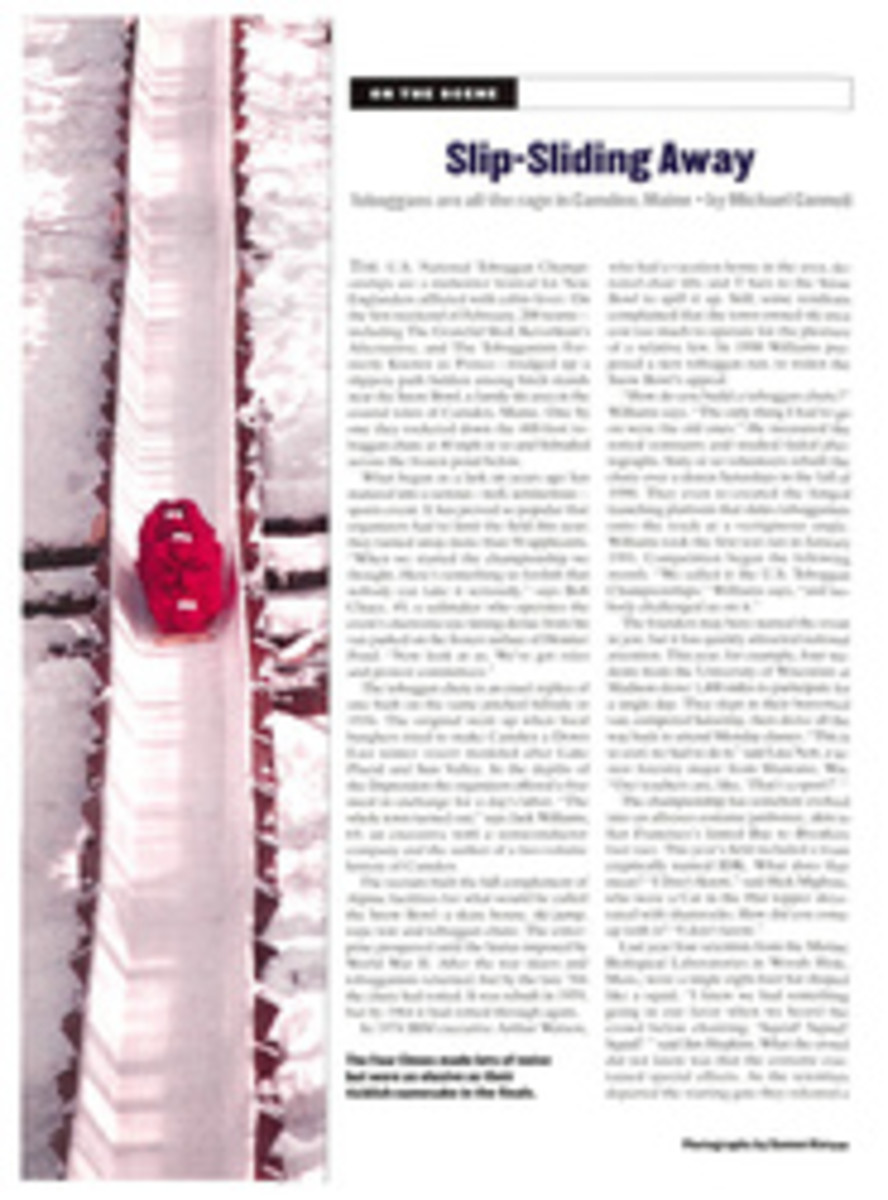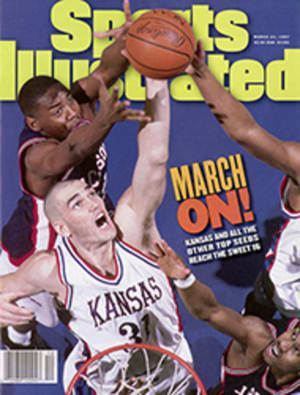
SLIP-SLIDING AWAY TOBOGGANS ARE ALL THE RAGE IN CAMDEN, MAINE
The U.S. National Toboggan Championships are a midwinter
festival for New Englanders afflicted with cabin fever. On the
first weekend of February, 200 teams--including The Grateful
Sled, Kevorkian's Alternative, and The Tobogganists Formerly
Known as Prince--trudged up a slippery path hidden among birch
stands near the Snow Bowl, a family ski area in the coastal town
of Camden, Maine. One by one they rocketed down the 400-foot
toboggan chute at 40 mph or so and fishtailed across the frozen
pond below.
What began as a lark six years ago has matured into a
serious--well, semiserious--sports event. It has proved so
popular that organizers had to limit the field this year; they
turned away more than 50 applicants. "When we started the
championship we thought, Here's something so foolish that nobody
can take it seriously," says Bob Chace, 49, a sailmaker who
operates the event's electronic-eye timing device from his van
parked on the frozen surface of Hosmer Pond. "Now look at us.
We've got rules and protest committees."
The toboggan chute is an exact replica of one built on the same
pitched hillside in 1936. The original went up when local
burghers tried to make Camden a Down East winter resort modeled
after Lake Placid and Sun Valley. In the depths of the
Depression the organizers offered a free meal in exchange for a
day's labor. "The whole town turned out," says Jack Williams,
69, an executive with a semiconductor company and the author of
a two-volume history of Camden.
The recruits built the full complement of Alpine facilities for
what would be called the Snow Bowl: a skate house, ski jump,
rope tow and toboggan chute. The enterprise prospered until the
hiatus imposed by World War II. After the war skiers and
tobogganists returned, but by the late '50s the chute had
rotted. It was rebuilt in 1959, but by 1964 it had rotted
through again.
In 1974 IBM executive Arthur Watson, who had a vacation home in
the area, donated chair lifts and T bars to the Snow Bowl to
spiff it up. Still, some residents complained that the
town-owned ski area cost too much to operate for the pleasure of
a relative few. In 1990 Williams proposed a new toboggan run, to
widen the Snow Bowl's appeal.
"How do you build a toboggan chute?" Williams says. "The only
thing I had to go on were the old ones." He measured the rotted
remnants and studied faded photographs. Sixty or so volunteers
rebuilt the chute over a dozen Saturdays in the fall of 1990.
They even re-created the hinged launching platform that slides
tobogganists onto the track at a vertiginous angle. Williams
took the first test run in January 1991. Competition began the
following month. "We called it the U.S. Toboggan Championships,"
Williams says, "and nobody challenged us on it."
The founders may have named the event in jest, but it has
quickly attracted national attention. This year, for example,
four students from the University of Wisconsin at Madison drove
1,400 miles to participate for a single day. They slept in their
borrowed van, competed Saturday, then drove all the way back to
attend Monday classes. "This is so cool, we had to do it," said
Lisa Nett, a senior forestry major from Shawano, Wis. "Our
teachers are, like, 'That's a sport?'"
The championship has somehow evolved into an alfresco costume
jamboree, akin to San Francisco's famed Bay to Breakers foot
race. This year's field included a team cryptically named IDK.
What does that mean? "I Don't Know," said Rick Migliore, who
wore a Cat in the Hat topper decorated with shamrocks. How did
you come up with it? "I don't know."
Last year four scientists from the Marine Biological
Laboratories in Woods Hole, Mass., wore a single eight-foot hat
shaped like a squid. "I knew we had something going in our favor
when we heard the crowd below chanting, 'Squid! Squid! Squid!'"
said Jim Hopkins. What the crowd did not know was that the
costume contained special effects. As the scientists departed
the starting gate they released a smoke bomb to simulate the
inky substance that squids spray at adversaries. This year the
scientists dressed as an octopus. "We're still in the cephalopod
family," said Hopkins, "but we're thinking sea urchin or sea
slug for next year."
Because winners prevail by only hundredths of a second, teams
scrounge for an edge. They slicken up their sleds with a
smorgasbord of ski waxes and secret solutions disguised with
code names like moose gel and whale lard. "I collect raccoons
from the side of the road," Migliore explained with an
impenetrable poker face. "I squeeze the intestines and boil them
down to clear paste." For all the professional talk of secretly
devised speed enhancements, some toboggans smelled suspiciously
of Lemon Pledge.
Veterans say the key to speed is to align the toboggan in the
starting gate so that it caroms off the flared chute walls as
little as possible. Folklore holds that a hearty bellow also
improves performance. "Noise is good," said Williams, nodding in
approval as four women costumed as The Four Elmos barreled
boisterously down the chute. "Noise helps."
The championships even have their own supplier. When
construction slowed during the early '90s, Dave Nazaroff, a
general contractor, advertised handcrafted toboggans in The
Camden Herald--even though he had never made one. He received
four Christmas orders on Dec. 19. "The next morning I set out to
teach myself how to make a toboggan," he says. "I slept only
intermittently that week." The polyurethane finish was still wet
when he delivered the toboggans late on Christmas Eve. Today
Nazaroff gets phone orders from hopeful racers as far away as
California. "People actually request winning toboggans," he
says. "I tell them that costs $25 more." He charges $175 for a
standard eight-foot toboggan and turns out about 50 a year.
If this year's championships had a top seed, it might well have
been the Throbbin' Boggins. These four Camdenites have been a
consistent contender in the four-person event (there are also
two-person and three-person divisions) since competitive sliding
began six years ago. "They're the Dallas Cowboys of
tobogganing," says Larry Thomas of the Slab City Sliders, a
perennial rival. "By comparison, we're only, say, the Pittsburgh
Steelers."
How do the Boggins account for their success? "We have some
secrets," Greg Holt coyly concedes. The four Boggins lunge
forward in unison as they exit the starting chute, then recline
in a streamlined posture with their legs linked around one
another's necks.
True to form, the Boggins were second in their division after
the two Saturday runs, with a combined time of 18.84, less than
half a second behind The Big Kahoonas. Meanwhile, the Slab City
Sliders languished in 13th place. Thomas smoothed his homemade
toboggan with a razor Saturday night, though he felt the Sliders
had little hope of a comeback in Sunday's final round. "We
thought we were out of it," he said. In fact, the Sliders
recovered with two fast runs to win it all by two hundredths of
a second.
The Throbbin' Boggins are already devising ways to accelerate
the descent of their sled next year. They divulge nothing for
now, except to say that they are pushing sledding's slippery
science.
Michael Cannell's most recent story for SI was on the
restoration of FDR's Hudson River ice yacht.
COLOR PHOTO: PHOTOGRAPHS BY DAMON KIESOW The Four Elmos made lots of noise but were as elusive as their ticklish namesake in the finals. [Four competitors dressed as Elmo on toboggan]
COLOR PHOTO: PHOTOGRAPHS BY DAMON KIESOW In their last two runs the Slab City Sliders hunkered down and went all the way from 13th to first. [Four competitors on toboggan]

